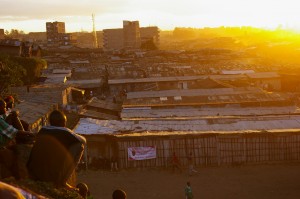The name Mathare is derived from the word ‘mathari’, which means ‘branch’ in the Kikuyu language. During colonial times Mathare was a quarry, where stones were quarried for use in construction. Mathare was not a valley…it became one by dint of digging. One day a worker decided to build a small hut. A seemingly insignificant gesture, no one noticed at the time. Once independence was achieved, many poor people began to migrate from their huts to Nairobi in search of work. Looking for cheap places to live that were close to the city, more and more people started building shacks next to our worker’s shack. All this without any master plan. Today Mathare has a population of 96,000 people squeezed into a small piece of land (1.5 square kilometres).
Mathare is located just 4 km from the centre of Nairobi. Reaching Mathare by public matatu is a variable: a time from 10 minutes to 2 hours, a price from 10 to 60 euro cents, a risk of accidents from zero to more infinite, a road not always defined…everything changes depending on the traffic!
They say you never forget your first time… this is especially true of Mathare. Your wimpy 5 western senses go crazy because they are suddenly overstimulated.
On an olfactory level, smells will seem extremely strong, harsh… alive! They go from the smell of rubbish, to that of fried food, to that of sweat. Mathare can be claustrophobic and at times you will feel like you can’t breathe. Trust me that after 2 weeks in Kenya your sweat will be perfectly aligned with the Kenyan standard: more intense, more acrid… more sweat in short.
Anything can happen to your ears. Since the shantytown has an exceptionally high population density, various noises will tend to collide and overlap: voices of students endlessly repeating a nursery rhyme in English, children chasing you, rhythmically chanting something that sounds like auariuuu (how are you from English), preachers of any religion who, in the grip of mystical visions, repeat alleluia every 6 seconds, the music of a small shop (in 70% of the cases it holds up), the walking chant of a vucumprà trying to place plastic buckets, the gunshots coming from a slum cinema where an action film with Chuck Norris is being shown.
Visually, it all depends on the vantage point. From above, you will see a jumble of metal sheets criss-crossing, overlapping and hiding most of the real slum life. When you are inside the shantytown the perspective changes. You walk through what from above looked like narrow, dead-end tunnels, you meet people who from above looked like busy ants, you come up against the real life of the people of Mathare, a life that strikes you as unexpectedly normal. It will be almost disappointing to see that you do everything you do in nearby Nairobi, there are the same services but at a price that can be even 10 times lower… in fact we can consider Mathare to all effects a city within a city. A two room accommodation for say 4 people in Mathare costs around 15 euros per month…a night at the nearby Hilton Hotel 150 euros per night.
Tactile level depends on your courage. Do you want to pick something up from the ground? At your own risk. Let’s say Mathare is not the place for Amuchina addicts. The hands you will shake in most cases are dry, lived, marked by daily manual work. If you happen to come down to Mathare during the rainy season then good luck. In the worst case scenario it will be like being the protagonists of an episode of ‘Mai Dire Banzai’ with muddy roads completely inaccessible to cross and with a risk of falling.
In terms of taste, let’s say that if you want to be on the safe side, the ideal thing is to eat something fried or at least something that has been cooked for so many hours that any possible virus is dead…as well as any semblance of flavour. If, on the other hand, you like to be daring, then I suggest the famous fish heads with an excellent broth. Better to open a parenthesis on fish heads. The diet of rich and poor in Nairobi is different: if you go to eat fish in a luxury hotel in the city centre, they will serve you fish without the heads. The heads are sold by the cooks to local businessmen who buy them for a few cents of a euro and then sell them fried the next day along the streets of the slums. Cost of a portion of fish in a hotel in the centre: 30 euros, cost in Mathare: 30 cents.
The first time in a shantytown for many is a psychological drama. You can arrive prepared, having read books, heard stories and seen photographs, but when you are in the middle of it, it will be completely new to you! It will all be very disorienting.
Welcome to Mathare!
Luca Marchina


